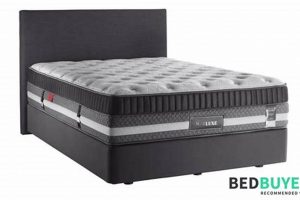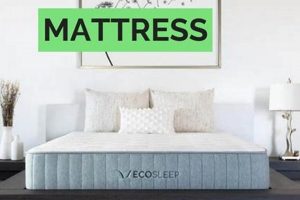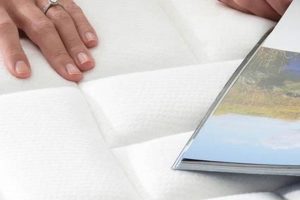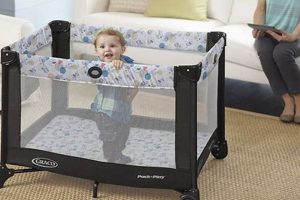A specialized sleeping surface, narrower and shorter than a standard queen, is designed to fit within the spatial constraints of recreational vehicles. The dimensions are typically around 60 inches wide by 75 inches long, providing a comfortable sleeping arrangement without occupying excessive floor space. For example, an RV owner seeking to maximize living area might opt for this bed size over a full-sized alternative.
Selecting the appropriate size offers significant advantages within the context of RV travel. Optimizing interior space allows for greater freedom of movement and increased storage capacity. Historically, RVs have faced limitations regarding sleeping accommodations; this specialized size addresses this challenge, providing a compromise between comfort and efficient space utilization. This contributes to a more pleasant and functional travel experience.
The following discussion will explore key considerations in selecting a suitable model, including material composition, support characteristics, and factors influencing overall sleep quality while on the road. Furthermore, this article will highlight specific mattress types and brands that are known for their durability, comfort, and ability to withstand the rigors of RV travel.
Selection Guidance for Specialized RV Mattresses
Effective decision-making requires careful consideration of several factors. Prioritizing material composition, support structure, and vehicle-specific constraints is critical for ensuring both comfort and longevity.
Tip 1: Assess Dimensional Constraints: Precisely measure the available sleeping platform within the recreational vehicle before initiating any purchase. Variations in RV models necessitate accurate measurements to avoid compatibility issues.
Tip 2: Prioritize High-Density Foam Construction: Mattresses incorporating high-density foam tend to exhibit superior resilience and provide enhanced support, mitigating the effects of prolonged use and variable environmental conditions.
Tip 3: Evaluate Support Systems: Examine the type of support system integrated into the mattress core. Options include innerspring coils, pocketed coils, or foam cores. The choice should align with individual preferences for firmness and motion isolation.
Tip 4: Consider Breathability: RV interiors can experience temperature fluctuations. Opt for materials with inherent breathability, such as open-cell foam or natural fibers, to promote airflow and regulate sleeping temperature.
Tip 5: Investigate Antimicrobial Properties: Given the enclosed environment of an RV, selecting a mattress with antimicrobial properties can help inhibit the growth of mold, mildew, and bacteria, thereby promoting a healthier sleeping environment.
Tip 6: Evaluate Weight Considerations: The weight of the mattress impacts the overall fuel efficiency and handling characteristics of the RV. Lighter materials, such as memory foam, can help minimize the added weight.
Careful consideration of these factors will facilitate the selection of a specialized RV mattress that optimizes comfort, durability, and overall sleeping quality within the confined space of a recreational vehicle.
The subsequent section will delve into specific mattress types and brands known for their suitability in RV applications, providing further guidance for informed purchasing decisions.
1. Dimensions
The term “short queen” directly implies a specific set of dimensional constraints, differentiating this mattress type from standard queen-size models. These mattresses are designed to fit within the limited space available in recreational vehicles. Inaccurate or ill-fitting mattresses can obstruct passage within the RV, interfere with the functionality of slide-outs, and potentially damage interior components during transit. For instance, a mattress exceeding the specified length may prevent a bedroom door from closing properly, thereby compromising privacy and climate control. Therefore, precise dimensional compatibility is a primary determinant of suitability when selecting an RV mattress.
Consider a scenario where an RV owner, without verifying the proper measurements, purchases a mattress marketed as “queen-size” but that conforms to standard residential dimensions. This mattress would likely prove too long, requiring modification or rendering the purchase unusable. Conversely, a mattress that is too small may create uncomfortable gaps between the mattress and the bed frame, leading to instability and a less restful sleep. The consequences of dimensional mismatches range from minor inconvenience to significant usability issues, all stemming from overlooking the crucial connection between dimensions and the intended RV application.
In summary, the dimensions are not merely a descriptive attribute but a fundamental requirement for the “best rv mattress short queen.” Ensuring dimensional accuracy is the first and most critical step in selecting a mattress that maximizes comfort and functionality within the confines of a recreational vehicle. Failure to prioritize this aspect can lead to practical challenges and diminish the overall RV travel experience. The specific need for space efficiency inherent in RV design necessitates this precise dimensional consideration.
2. Material Density
Material density, measured as mass per unit volume, significantly impacts the performance and longevity of a mattress, particularly within the context of RV applications. Higher density foams, commonly found in premium mattresses, exhibit enhanced resistance to compression and deformation over extended periods. This attribute is critical for recreational vehicles, where mattresses are subjected to frequent use and potential environmental stressors such as temperature fluctuations and humidity. Low-density foams, while often more affordable, tend to break down more rapidly, resulting in diminished support, increased sagging, and a reduced lifespan, ultimately compromising sleep quality and necessitating premature replacement. Thus, the density of the foam directly correlates to the overall value and suitability of a “best rv mattress short queen.”
Consider two hypothetical RV mattresses, both conforming to the short queen dimensions. One utilizes a memory foam core with a density of 5 lbs per cubic foot, while the other employs a similar foam with a density of 2 lbs per cubic foot. Over time, the higher-density mattress will retain its shape and supportive characteristics to a greater extent, distributing weight more evenly and minimizing pressure points. The lower-density mattress, conversely, will exhibit noticeable compression and sagging in areas of concentrated weight, leading to discomfort and potential back pain. This difference is further exacerbated by the conditions within an RV, where temperature variations can accelerate the degradation of low-density materials. Selecting a “b
est rv mattress short queen” necessitates a thorough evaluation of material density specifications.
In summary, material density is a fundamental parameter that dictates the durability, support, and long-term performance of a mattress. For the specific needs of RV travel, higher density materials are demonstrably superior, offering increased resistance to wear and tear, improved weight distribution, and enhanced sleep quality. While initial cost may be a factor, the long-term value and overall comfort afforded by high-density construction ultimately justify the investment in a “best rv mattress short queen.” Choosing a mattress with inadequate density presents a false economy, resulting in frequent replacements and a compromised travel experience.
3. Support Structure
Support structure within an RV mattress dictates its ability to properly align the spine, distribute weight, and maintain its form under varying conditions. The design directly impacts comfort, durability, and suitability for the confined space of a recreational vehicle. Therefore, understanding the different types of support structures is critical when selecting the “best rv mattress short queen”.
- Innerspring Systems
Innerspring systems utilize interconnected coils to provide a consistent level of support. The gauge and configuration of the coils determine the firmness and responsiveness of the mattress. While typically more affordable, innerspring systems can transfer motion easily, potentially disturbing a sleeping partner. Moreover, the metal components are susceptible to corrosion in humid environments, a concern in some RV settings. For the “best rv mattress short queen”, an innerspring system must be carefully selected for coil density and material quality.
- Pocketed Coil Systems
Pocketed coil systems encase each spring individually in fabric pockets. This design minimizes motion transfer and allows each coil to respond independently to pressure, contouring to the body. This offers potentially better support and comfort compared to traditional innerspring systems. However, pocketed coil systems can add to the overall weight of the mattress, which must be considered in relation to the RV’s weight capacity. For the “best rv mattress short queen,” a pocketed coil system represents a significant upgrade, but its weight impact requires careful evaluation.
- Foam Core Systems
Foam core systems utilize various foam types, such as memory foam, latex, or polyurethane foam, to provide support. These systems can be engineered to offer varying levels of firmness and contouring. High-density foam cores offer superior support and durability compared to lower-density options. Foam cores are often lighter than innerspring systems, making them a suitable choice for RVs where weight is a concern. The “best rv mattress short queen” frequently employs a foam core, prioritizing both comfort and weight reduction.
- Hybrid Systems
Hybrid systems combine elements of innerspring and foam core designs. Typically, these mattresses feature a pocketed coil base layer topped with layers of memory foam or latex. This design aims to provide the support of a coil system with the comfort and contouring of foam. Hybrid systems can offer a balance of support, comfort, and motion isolation. However, they can be more expensive and heavier than all-foam or all-innerspring mattresses. For the “best rv mattress short queen,” a hybrid system represents a high-end option, offering potentially superior performance at a premium price point.
In summary, the support structure is a critical determinant of the overall quality and suitability of the “best rv mattress short queen”. Different support systems offer varying levels of support, comfort, motion isolation, and durability. The optimal choice depends on individual preferences, budget constraints, and the specific requirements of the recreational vehicle. Weight limitations, environmental factors, and the need for motion isolation must all be considered when evaluating the available options. Understanding the characteristics of each support system is essential for making an informed decision.
4. Temperature Regulation
Temperature regulation within a mattress directly influences sleep quality, particularly in the variable environmental conditions often encountered in recreational vehicles. Fluctuations in ambient temperature, coupled with the inherent insulating properties of bedding materials, can lead to overheating or chilling during sleep. Mattresses lacking effective temperature regulation contribute to discomfort, restlessness, and disrupted sleep cycles. The “best rv mattress short queen” incorporates design features and materials specifically engineered to mitigate these temperature-related issues. For example, open-cell foam structures facilitate airflow, allowing body heat to dissipate more efficiently compared to closed-cell alternatives. Similarly, fabrics with moisture-wicking properties help to draw perspiration away from the skin, promoting a cooler and drier sleeping environment. The incorporation of such temperature-regulating features is paramount for achieving restorative sleep within the context of RV travel.
Real-world examples illustrate the practical significance of temperature regulation in RV mattresses. Consider an individual traveling through a desert region. During the day, the RV interior may reach high temperatures, while nighttime temperatures can drop dramatically. A mattress lacking effective temperature regulation would trap heat during warmer periods, leading to excessive sweating and discomfort. Conversely, during cooler periods, the same mattress may fail to provide adequate insulation, resulting in chilling and sleep disruption. In contrast, a mattress with integrated temperature-regulating technologies adapts to these changing conditions, maintaining a more consistent and comfortable sleeping environment. Gel-infused memory foam, for instance, absorbs and releases heat, moderating temperature fluctuations and enhancing sleep quality. Understanding these practical implications underscores the importance of temperature regulation as a key attribute of the “best rv mattress short queen”.
In summary, temperature regulation is not merely a comfort feature but a critical component of the “best rv mattress short queen,” directly impacting sleep quality and overall well-being during RV travel. The challenges posed by variable environmental conditions necessitate the selection of mattresses with advanced temperature-regulating technologies. Open-cell foam, moisture-wicking fabrics, and gel infusions represent viable solutions for mitigating temperature fluctuations and promoting restorative sleep. Prioritizing temperature regulation is essential for optimizing the RV travel experience and ensuring a consistently comfortable sleeping environment. Therefore, thorough assessment of temperature-regulating capabilities should be an integral part of the mattress selection process.
5. Antimicrobial Properties
Antimicrobial properties in a mattress serve as a critical defense against the proliferation of microorganisms, a particularly pertinent
consideration within the enclosed environment of a recreational vehicle. The “best rv mattress short queen” should ideally incorporate antimicrobial treatments or materials to mitigate the risks associated with bacterial, fungal, and other microbial growth, contributing to a healthier and more hygienic sleeping environment.
- Mold and Mildew Resistance
RVs are often exposed to varying humidity levels, creating conditions conducive to mold and mildew growth within the mattress. Antimicrobial treatments inhibit the development of these organisms, preventing unpleasant odors, discoloration, and potential allergic reactions. For the “best rv mattress short queen”, mold and mildew resistance is essential for maintaining a sanitary sleeping surface, particularly in regions with high humidity or fluctuating temperatures.
- Bacterial Growth Inhibition
Mattresses can accumulate bacteria from sweat, skin cells, and other bodily fluids. Antimicrobial agents disrupt bacterial cell growth, reducing the risk of unpleasant odors and preventing the spread of potential pathogens. The “best rv mattress short queen” utilizes bacterial growth inhibition to minimize the risk of odors and ensure a cleaner sleeping environment over extended periods.
- Dust Mite Control
Dust mites are microscopic organisms that thrive in bedding and can trigger allergic reactions in sensitive individuals. Antimicrobial treatments can create an inhospitable environment for dust mites, reducing their population within the mattress. The “best rv mattress short queen” benefits from dust mite control, contributing to improved air quality within the RV and reducing allergy-related symptoms.
- Material Degradation Prevention
Microbial growth can contribute to the degradation of mattress materials over time, leading to premature wear and tear. Antimicrobial properties protect the mattress core and cover from microbial damage, extending its lifespan and preserving its structural integrity. For the “best rv mattress short queen”, this protection against material degradation translates to enhanced durability and long-term value.
The integration of antimicrobial properties into the “best rv mattress short queen” represents a proactive approach to maintaining hygiene, mitigating health risks, and extending the lifespan of the mattress. These features are particularly relevant in the confined and potentially humid environment of a recreational vehicle, where the prevention of microbial growth is paramount for ensuring a comfortable and healthy travel experience.
6. Weight Impact
The weight of a mattress selected for recreational vehicle use is a critical consideration, directly impacting fuel efficiency, vehicle handling, and overall safety. Selecting the “best rv mattress short queen” necessitates a careful assessment of its weight characteristics to ensure compatibility with the RV’s load capacity and operational parameters.
- Fuel Efficiency Reduction
Excess weight added to an RV directly reduces fuel efficiency. A heavier mattress increases the vehicle’s overall mass, requiring the engine to expend more energy to maintain speed and navigate varying terrains. The cumulative effect of even a seemingly small weight increase can be significant over extended travel distances. For example, adding a mattress that is 50 pounds heavier than an alternative can noticeably decrease miles per gallon, resulting in increased fuel costs throughout a trip. The “best rv mattress short queen” minimizes this impact by prioritizing lightweight materials without sacrificing comfort and support.
- Vehicle Handling Compromise
Excessive weight negatively affects vehicle handling, particularly during cornering, braking, and maneuvering in challenging conditions. A heavier mattress shifts the center of gravity, potentially making the RV less stable and more prone to sway. This can be especially problematic on winding roads or in adverse weather. The “best rv mattress short queen” maintains safe handling by utilizing lightweight materials, thus minimizing any adverse impact on the vehicle’s stability and responsiveness.
- Load Capacity Exceedance
Every RV has a specified load capacity, representing the maximum allowable weight of passengers, cargo, and equipment. Exceeding this limit can damage the vehicle’s suspension system, tires, and other critical components, posing a safety risk. A heavy mattress contributes to the overall load and can potentially push the RV beyond its safe operating parameters. The “best rv mattress short queen” is designed to be lightweight to avoid exceeding the RV’s load capacity, ensuring safe and reliable operation.
- Tire Stress Amplification
Tires bear the entire weight of the RV, and excessive weight increases stress and wear. Overloaded tires are more susceptible to blowouts, particularly during hot weather or prolonged travel. A heavier mattress contributes to the overall tire load, potentially reducing tire lifespan and increasing the risk of tire failure. The “best rv mattress short queen” reduces this risk by prioritizing lightweight materials, minimizing the strain on the tires and contributing to safer travel.
Therefore, careful consideration of weight is paramount when selecting the “best rv mattress short queen.” Prioritizing lightweight materials, without compromising comfort and support, is essential for maintaining fuel efficiency, preserving vehicle handling, staying within load capacity limits, and minimizing tire stress. A lightweight mattress contributes to a safer, more efficient, and more enjoyable RV travel experience.
Frequently Asked Questions
The following addresses common inquiries regarding mattresses specifically designed for recreational vehicles, adhering to the “short queen” size standard.
Question 1: What are the precise dimensions of a “short queen” mattress, and why are these dimensions crucial for RV applications?
A “short queen” mattress typically measures 60 inches in width and 75 inches in length. These reduced dimensions are essential for accommodating the spatial constraints inherent in most RV sleeping areas. Standard queen mattresses (80 inches in length) are often too long to fit comfortably, impeding movement and potentially interfering with slide-out mechanisms.
Question 2: What material properties distinguish a “best rv mattress short queen” from a standard residential mattress?
Optimal RV mattresses prioritize lightweight construction, durable materials, and temperature regulation capabilities. High-density foam cores, moisture-wicking fabrics, and antimicrobial treatments are frequently incorporated to enhance comfort, longevity, and hygiene within the often-confined RV environment. Standard residential mattresses may not prioritize these specific attributes to the same extent.
Question 3: How does mattress weight affect the performance and safety of a recreational vehicle?
Excessive mattress weight negatively impacts fuel efficiency, vehicle handling, and load capacity. Heavier mattresses increase fuel consumption, compromise stability during maneuvering, and potentially exceed the RV’s safe operating limits. The “best rv mattress short queen” minimizes weight without sacrificing support and comfort, contributing to safer and more efficient travel.
Question 4: Are antimicrobial properties essential for an RV mattress, and what benefits do they provide?
Antimi
crobial properties are highly beneficial in RV mattresses due to the potential for humidity and limited ventilation. These treatments inhibit the growth of mold, mildew, and bacteria, reducing odors, preventing material degradation, and promoting a healthier sleeping environment. This is especially crucial in the enclosed space of an RV.
Question 5: What types of support structures are commonly found in RV mattresses, and which is considered most suitable?
Common support structures include innerspring coils, pocketed coils, and foam cores (memory foam, latex, etc.). Foam cores are often favored in RV applications due to their lighter weight and ability to provide adequate support and contouring. However, the optimal choice depends on individual preferences and budgetary considerations.
Question 6: How should temperature regulation be addressed when selecting a “best rv mattress short queen”?
Effective temperature regulation is crucial for comfort during RV travel. Mattresses should incorporate breathable materials, such as open-cell foam or moisture-wicking fabrics, to dissipate heat and minimize temperature fluctuations. Gel-infused memory foam can also enhance temperature regulation by absorbing and releasing heat as needed.
These FAQs underscore the importance of selecting a mattress specifically designed for the unique challenges and constraints of RV travel. Consideration of dimensions, materials, weight, antimicrobial properties, support structure, and temperature regulation is paramount for ensuring a comfortable and healthy sleeping environment.
The subsequent section will provide guidance on selecting and purchasing a suitable mattress for individual RV needs.
Conclusion
The preceding analysis has thoroughly examined critical facets of the “best rv mattress short queen,” underscoring the significance of dimensional accuracy, material density, support structure, temperature regulation, antimicrobial properties, and weight considerations. Optimal mattress selection necessitates a comprehensive understanding of these interlinked factors to ensure both comfort and long-term performance within the unique environment of a recreational vehicle.
The selection of a suitable RV mattress represents a substantial investment in travel comfort and overall well-being. Given the diverse range of available options, diligent research and careful evaluation are essential. RV owners are encouraged to prioritize mattresses engineered to meet the specific demands of mobile living, thereby maximizing their enjoyment of the open road and ensuring restful sleep throughout their journeys. The longevity and comfort derived from a well-chosen mattress significantly contribute to the overall RV experience.


![Top-Rated: Choosing the Best Mattress Foundation [Guide] Organic & Natural Mattress Buyer’s Guide: Non-Toxic Sleep Solutions Top-Rated: Choosing the Best Mattress Foundation [Guide] | Organic & Natural Mattress Buyer’s Guide: Non-Toxic Sleep Solutions](https://mattressworldpa.com/wp-content/uploads/2025/07/th-7633-300x200.jpg)




![How to Find the Best Way Twin Air Mattress [Guide] Organic & Natural Mattress Buyer’s Guide: Non-Toxic Sleep Solutions How to Find the Best Way Twin Air Mattress [Guide] | Organic & Natural Mattress Buyer’s Guide: Non-Toxic Sleep Solutions](https://mattressworldpa.com/wp-content/uploads/2025/07/th-7628-300x200.jpg)